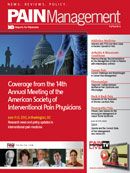Primary Care Options for the Nonsurgical Management of Carpal Tunnel Syndrome
Carpal tunnel syndrome (CTS) is the most common entrapment neuropathy. Its definitive treatment is carpal tunnel release, the most common hand surgery in America, but nonsurgical management options are also available.
Carpal tunnel syndrome (CTS) is the most common entrapment neuropathy. Its definitive treatment is carpal tunnel release, the most common hand surgery in America, but nonsurgical management options are also available.
Clinical guidelines prepared by the American Academy of Orthopaedic Surgeons (http://bit.ly/LRxnQv) defines carpal tunnel syndrome (CTS) as “a symptomatic compression neuropathy of the median nerve at the level of the wrist, characterized physiologically by evidence of increased pressure within the carpal tunnel and decreased function of the nerve at that level.” Patients with potential CTS experience an array of symptoms, including pain and intermittent, increasing paresthesia, or burning in the hand and fingers. These symptoms typically worsen at night or with repetitive activity. During physical examination, a positive Phalen’s test and/or a positive Tinel’s test are highly suggestive of CTS. More advanced cases may be associated with decreased sensation or strength, and persistent numbness with difficulty grasping, indicating neurologic deficits.
Steven P. Stanos, DO, Medical Director of the Rehabilitation Institute of Chicago Center for Pain Management (and advisory board member of Pain Management), says that when evaluating patients for potential CTS, he relies on a thorough physical exam and history, patient-reported metrics (such as the Verbal Rating Scale) and electrodiagnostic studies such as electromyography (EMG) and nerve conduction studies, which can objectively measure nerve function and confirm CTS diagnoses.
Nerve conduction studies (NCS) administer slight shocks to the skin overlying the nerve. Nerve conduction velocity (NCV) tests are highly sensitive and specific for CTS. Normal NCS indicate CTS may not be present; further testing should follow. In EMG, needles inserted into patients’ muscles assess electrical activity in the muscle.
Edward Magaziner, MD, CEO of the New Jersey Society of Interventional Pain Physicians and Medical Director of the NJ Center for Spine, Sports, Pain Management, and Orthopedic Regenerative Medicine (and Pain Management advisory board member), assesses patients for CTS by conducting a thorough physical examination, supplemented with electrodiagnostic studies, and sometimes MRI/CT scans. He says “NCS combined with EMG is the gold standard for diagnosis,” enabling clinicians to differentiate CTS from general nerve disease or neck pathologies from problems like thyroid or renal disease. “We look for neck problems as well, including subluxation or spasms that can lead to CTS. Other risks include herniated disc, swelling, diabetes, hypothyroid—all medical conditions that can lead to CTS,” he says.
"We look for neck problems as well, including subluxation or spasms that can lead to CTS. Other risks include herniated disc, swelling, diabetes, hypothyroid—all medical conditions that can lead to CTS."
—Edward Magaziner, MD CEO, NJSIPP Medical Director, NJ Center for Spine, Sports, Pain Management, and Orthopedic Regenerative Medicine
Nonsurgical treatment options
Physicians can nonsurgically treat patients with tolerable CTS symptoms and no progressive neurologic or functional deficits. Stanos says that he will initiate treatment “when patients’ symptoms are too painful and affecting their function, like any pain condition.” Like many of his colleagues, he says that he generally tries conservative measures first.
Splinting is a common approach to CTS therapy. It is inexpensive, and can improve pain, strength, numbness, nocturnal paresthesias, and NCV in some patients. Although several types of splinting are frequently used (including neutral wrist position splints, and soft splints that hold the metacarpophalangeal joint in extension), the authors of one study (http://1.usa.gov/KMQRjH) noted that the data is unclear on which form provides the most benefit. The authors of another study comparing soft hand braces and wrist splints in patients with CTS found that both approaches produce “symptomatic and functional benefit” (http://1.usa.gov/MbY0de).
Corticosteroid carpal tunnel injections “are frequently used to treat CTS, and are considered to be both safe and effective for shortterm management” (http://1.usa.gov/KMQRjH). In randomized controlled trials, injections improved dexterity, function, and electrophysiologic testing results. While some patients may experience long-term relief of CTS symptoms with corticosteroid injection, patients may become refractory to repeated injections.
Stanos says he has recommended off-label use of NSAIDs, and some anticonvulsants for patients with CTS. “We also recommend wrist splints for nighttime use, physical or occupational therapy, and wrist injections of corticosteroids,” he says.
Physical therapy, alternative medicine, and other approaches
Physical and occupational therapies can restore function with modalities like deep, pulsed ultrasound, which can improve pain, strength, paresthesia, sensory loss, and nerve conduction without adverse effects. Common mobilization exercises like tendon and nerve gliding may improve nerve conduction, but their effectiveness isn’t well documented. Studies of the use of hand traction devices to increase the carpal tunnel area by stretching the transverse carpal ligament have produced mixed results.
Limited evidence suggests safe therapeutic effectiveness of acupuncture with needles or low-level lasers as adjunct or alternative treatment for decreasing pain, sensory latency, paresthesias, and nocturnal awakening, without adverse effects.
For Magaziner, the standard therapy for CTS is rest, exercise (including yoga/mindfulness techniques), reducing the tasks and repetitive motions that exacerbate symptoms, ergonomic evaluation, and stretching. He may also recommend physical therapy or chiropractic, ultrasound, massage, light strengthening exercises, or neural mobilization.
With mild cases, physicians can monitor symptoms for 3-6 months. Often, patients improve from moderate conservative measures. Physicians should consider surgery upon “failure of conservative measures, progressive weakness, worsening pain, worsening function,” says Stanos. Surgery appears most effective long-term for severe, EDS-confirmed symptoms. Because CTS usually progresses, patients who wait may have advanced (possibly permanent) nerve damage, making complete recovery harder. Generally, moderate cases show the greatest improvement.
